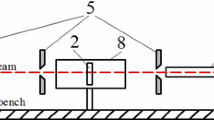Abstract
Nanoparticles have garnered significant interest because of their ability to enhance greatly the optical properties of the base fluid in which they are suspended. The optical properties of nanoparticles are sensitive to the materials used, as well as to the host medium. Most fluids exhibit refractive indices that are highly temperature-dependent, resulting in nanoparticle suspensions which also exhibit temperature-dependent optical properties. Previous work has shown that temperature increases result in decreased absorption in nanoparticle suspensions. Here, we expand previous work to include core–shell particles due to the potential spectral shifts in optical properties that will arise from the base fluid with temperature changes and the role of agglomeration under temperature cycling through both experimental and numerical efforts. Thermal cycling tests for silica and gold, the constituents of the core–shell nanoparticles used in this study, were tested to determine the extent of particle agglomeration resulting from up to 200 accelerated heating cycles. Optical properties were recorded after heating two base fluids (water and ethylene glycol) with multiple surfactants for silver nanospheres and silica–gold core–shell nanoparticles. It was found that the temperature results in a small increase in the transmittance for both particle types and a blue shift in the spectral transmittance for core–shell nanoparticles. Further, the coupling effect of temperature and agglomeration played a significant role in determining both the spectral properties—particularly the resulting transmittance—of the silver nanoparticle suspensions.












Similar content being viewed by others
References
Averitt RD, Westcott SL, Halas NJ (1999) Linear optical properties of gold nanoshells. J Opt Soc Am B 16:1824. doi:10.1364/JOSAB.16.001824
Bohren CF, Huffman DR (1998) Absorption and scattering of light by small particles, p 544. John Wiley & Sons, New York, NY
Cussler EL (2009) Diffusion: mass transfer in fluid systems. Cambridge University Press, Cambridge
Han D, Meng Z, Wu D et al (2011) Thermal properties of carbon black aqueous nanofluids for solar absorption. Nanoscale Res Lett 6:457. doi:10.1186/1556-276X-6-457
Howell JR, Siegel R, Pinar Menguc M (2011) Thermal radiation heat transfer, 5th edn. CRC Press, Boca Raton, FL
Kreibig U, Vollmer M (2010) Optical properties of metal clusters. Springer, New York, NY
Kumar S, Tien CL (1990a) Analysis of combined radiation and convection in a particulate-laden liquid film. J Sol Energy Eng 112:293–300
Kumar S, Tien CL (1990b) Dependent absorption and extinction of radiation by small particles. J Heat Transf (Transactions of the ASME (American Society of Mechanical Engineers), Series C); (United States) 112:1
Lee BJ, Park K, Walsh T, Xu L (2012) Radiative heat transfer analysis in plasmonic nanofluids for direct solar thermal absorption. J Sol Energy Eng 134:021009. doi:10.1115/1.4005756
Lv W, Phelan PE, Swaminathan R et al (2013) Multifunctional core-shell nanoparticle suspensions for efficient absorption. J Sol Energy Eng 135:021005. doi:10.1115/1.4007845
Mätzler C (2002) MATLAB functions for Mie scattering and absorption version 1. University of Bern, Bern, Switzerland
Mercatelli L, Sani E, Zaccanti G et al (2011) Absorption and scattering properties of carbon nanohorn-based nanofluids for direct sunlight absorbers. Nanoscale Res Lett 6:282. doi:10.1186/1556-276X-6-282
Mock JJ, Smith DR, Schultz S (2003) Local refractive index dependence of plasmon resonance spectra from individual nanoparticles. Nano Lett 3:485–491. doi:10.1021/nl0340475
Nanosight (2012) Nanoparticle size analysis, particle size software, LM10-HS-Products-NanoSight
Nozawa K, Gailhanou H, Raison L et al (2005) Smart control of monodisperse Stöber silica particles: effect of reactant addition rate on growth process. Langmuir 21:1516–1523. doi:10.1021/la048569r
Otanicar TP, Phelan PE, Golden JS (2009) Optical properties of liquids for direct absorption solar thermal energy systems. Sol Energy 83:969–977. doi:10.1016/j.solener.2008.12.009
Otanicar TP, Phelan PE, Prasher RS et al (2010) Nanofluid-based direct absorption solar collector. J Renew Sustain Energy 2:033102. doi:10.1063/1.3429737
Otanicar T, Brunter S, Higgins B et al (2012) Temperature dependent optical properties of nanoparticle suspensions. 2012 ASME Heat Transfer Conference
Sacadura J-F (2011) Thermal radiative properties of complex media: theoretical prediction versus experimental identification. Heat Transfer Eng 32:754–770. doi:10.1080/01457632.2011.525140
Sani E, Barison S, Pagura C et al (2010) Carbon nanohorns-based nanofluids as direct sunlight absorbers. Opt Express 18:4613–4616. doi:10.1007/s00170-008-1876-8(2009
Schuller JA, Barnard ES, Cai W et al (2010) Plasmonics for extreme light concentration and manipulation. Nat Mater 9:193–204. doi:10.1038/nmat2630
Sommer M, Stenger F, Peukert W, Wagner NJ (2006) Agglomeration and breakage of nanoparticles in stirred media mills—a comparison of different methods and models. Chem Eng Sci 61:135–148. doi:10.1016/j.ces.2004.12.057
Taylor RA, Phelan PE (2009) Pool boiling of nanofluids: comprehensive review of existing data and limited new data. Int J Heat Mass Transf 52:5339–5347. doi:10.1016/j.ijheatmasstransfer.2009.06.040
Taylor RA, Phelan PE, Otanicar TP et al (2011a) Nanofluid optical property characterization: towards efficient direct absorption solar collectors. Nanoscale Res Lett 6:225. doi:10.1186/1556-276X-6-225
Taylor RA, Phelan PE, Otanicar TP et al (2011b) Applicability of nanofluids in high flux solar collectors. J Renew Sustain Energy 3:023104. doi:10.1063/1.3571565
Taylor R, Coulombe S, Otanicar T et al (2013) Small particles, big impacts: a review of the diverse applications of nanofluids. J Appl Phys 113:011301. doi:10.1063/1.4754271
Wang X-Q, Mujumdar AS (2007) Heat transfer characteristics of nanofluids: a review. Int J Therm Sci 46:1–19. doi:10.1016/j.ijthermalsci.2006.06.010
Wang P, Huang B, Dai Y, Whangbo M-H (2012) Plasmonic photocatalysts: harvesting visible light with noble metal nanoparticles. Phys Chem Chem Phys 14:9813–9825. doi:10.1039/c2cp40823f
Winsemius P, van Kampen FF, Lengkeek HP, van Went CG (1976) Temperature dependence of the optical properties of Au, Ag and Cu. J Phys F Met Phys 6:1583–1606. doi:10.1088/0305-4608/6/8/017
Yu W, Xie H (2012) A review on nanofluids: preparation, stability mechanisms, and applications. J Nanomater 2012:1–17. doi:10.1155/2012/435873
Acknowledgments
T.P.O, J.H., and M.F. gratefully acknowledge the support of the US National Science Foundation through award CBET-1262201. R.A.T. acknowledges the financial support of the Transfield Foundation.
Author information
Authors and Affiliations
Corresponding author
Rights and permissions
About this article
Cite this article
Otanicar, T., Hoyt, J., Fahar, M. et al. Experimental and numerical study on the optical properties and agglomeration of nanoparticle suspensions. J Nanopart Res 15, 2039 (2013). https://doi.org/10.1007/s11051-013-2039-x
Received:
Accepted:
Published:
DOI: https://doi.org/10.1007/s11051-013-2039-x




